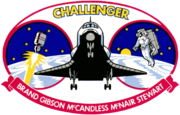 Bruce McCandless II demonstrates the Manned Maneuvering Unit (MMU), floating in space above a clouded Earth. | |
| Names | Space Transportation System-41B STS-11 |
|---|---|
| Mission type | Communications satellites deployment Equipment testing |
| Operator | NASA |
| COSPAR ID | 1984-011A |
| SATCAT no. | 14681 |
| Mission duration | 7 days, 23 hours, 15 minutes, 55 seconds |
| Distance travelled | 5,329,150 km (3,311,380 mi) |
| Orbits completed | 128 |
| Spacecraft properties | |
| Spacecraft | Space Shuttle Challenger |
| Launch mass | 113,603 kg (250,452 lb) |
| Landing mass | 91,280 kg (201,240 lb) |
| Payload mass | 12,815 kg (28,252 lb)[1] |
| Crew | |
| Crew size | 5 |
| Members | |
| EVAs | 2 |
| EVA duration |
|
| Start of mission | |
| Launch date | February 3, 1984, 13:00:00 UTC (8:00 am EST) |
| Launch site | Kennedy, LC-39A |
| Contractor | Rockwell International |
| End of mission | |
| Landing date | February 11, 1984, 12:15:55 UTC (7:15:55 am EST) |
| Landing site | Kennedy, SLF Runway 15 |
| Orbital parameters | |
| Reference system | Geocentric orbit[2] |
| Regime | Low Earth orbit |
| Perigee altitude | 307 km (191 mi) |
| Apogee altitude | 317 km (197 mi) |
| Inclination | 28.50° |
| Period | 90.80 minutes |
 STS-41-B mission patch  Standing: Stewart, McNair and McCandless. Stewart and McCandless are wearing Extravehicular Mobility Units (EMUs). Seated: Brand and Gibson | |
STS-41-B was NASA's tenth Space Shuttle mission and the fourth flight of the Space Shuttle Challenger. It launched on February 3, 1984 and landed on February 11, 1984, after deploying two communications satellites. It was also notable for including the first untethered spacewalk.
Following STS-9, the flight numbering system for the Space Shuttle program was changed. Because the original successor to STS-9, STS-10, was canceled due to payload delays, the next flight, originally and internally designated STS-11,[3][4] became STS-41-B as part of the new numbering system.
- ^ "NASA shuttle cargo summary" (PDF). NASA. Archived from the original (PDF) on August 31, 2000. Retrieved August 15, 2015.
 This article incorporates text from this source, which is in the public domain.
This article incorporates text from this source, which is in the public domain.
- ^ McDowell, Jonathan. "SATCAT". Jonathan's Space Report. Retrieved March 23, 2014.
- ^ Legler, Robert D.; Bennett, Floyd V. (September 2011). "Space Shuttle Missions Summary" (PDF). Mission Operations Johnson Space Center. p. 2-10. Retrieved December 21, 2023.
- ^ Barton, Dick; Cometa, Sue; Gordon, Bob; Green, Bill; Howard, Bob; Schilder, Shirley (January 1984). "41-B Press Information" (PDF). Rockwell International Office of Public Relations. p. 1. Retrieved December 21, 2023.